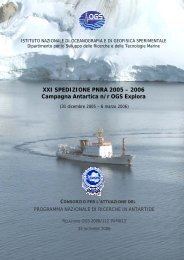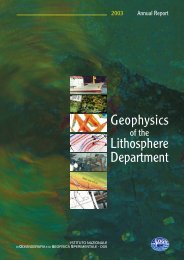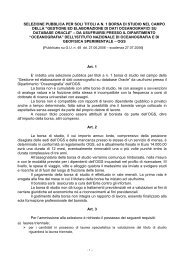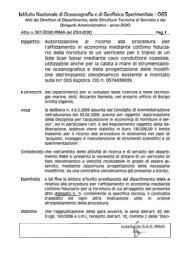Geophysical data acquisition - OGS
Geophysical data acquisition - OGS
Geophysical data acquisition - OGS
You also want an ePaper? Increase the reach of your titles
YUMPU automatically turns print PDFs into web optimized ePapers that Google loves.
three wells in the Blake Ridge, offshore southern United States. Here, a strong<br />
‘BSR’ marks a transition from a hydrate rich sediments zone above, to a free gas<br />
bearing sediments below. This transition is reflected in the velocity profile with a<br />
boundary at 4150 ms between a high velocity region (1670 m/s above) and a low<br />
velocity one (1500/1600 m/s below) (Figure B).<br />
A velocity structure obtained by prediction can be translated in gas hydrate and<br />
free gas concentration structure. We used the method proposed by Tinivella<br />
(1999). The concentration is estimated by fitting the theoretical velocity to the<br />
experimental P/wave velocity (derived by the prediction of the VSP in our case).<br />
The discrepancies between the inverted velocity profile and the velocity for water<br />
filled marine sediments are interpreted as due to the presence of the gas hydrate<br />
(where positive anomalies are present) and free gas (where negative anomalies are<br />
present). Figure C shows the distribution of the two phases: positive values (red<br />
colours) are the gas hydrate concentration, while negative concentrations (blue<br />
colours) are related to the percentage of volume occupied by free gas.<br />
A<br />
VSP velocity Section<br />
B<br />
A) Position map of the<br />
study area. Wells<br />
location and seismic<br />
line position are shown<br />
in the close-up<br />
window.<br />
B) VSP velocity panel.<br />
C) Distribution of the<br />
two gas phases;<br />
positive values (red<br />
colours) are the gas<br />
hydrate concentration,<br />
while the negative<br />
concentrations (blue<br />
colour).<br />
C<br />
50






